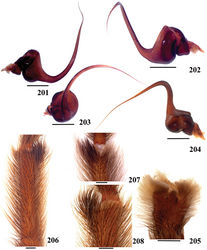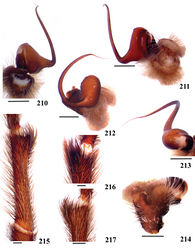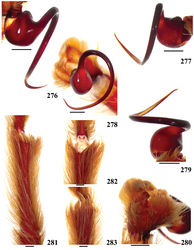| [[File:|center|border|250x250px|']] | ' |
| Figure 3. Approximate distribution area of Aviculariinae. ? = dubious record. |
| [[File:|center|border|250x250px|']] | ' |
| Figures 15–18. Urticating setae type II in Aviculariinae. 15 Avicularia juruensis male (CAS 4), showing well-developed barbs along all its length 16 Avicularia variegata stat. n. female (IBSP 7900), showing weakly-developed barbs only near the stalk 17 Avicularia avicularia female morphotype 5 (MNRJ 06916) from Pando, showing developed barbs along almost entire length 18 Caribena versicolor comb. n. male (MNHN−AR 4904), very slender setae with barbs along all length. Scale bars = 0.1 mm. |
| Figures 21–27. Avicularia avicularia (Linnaeus, 1758), spermathecae variation. 21 morphotype 1, Altamira, state of Pará, Brazil (MNRJ 13995) 22 morphotype 2, UHE Tucuruí, state of Pará, Brazil (IBSP 4885) 23 morphotype 3, Puerto Cabello, state of Carabobo, Venezuela (MNHN–AR 4883) 24 morphotype 4, Cuenca Rio Los Amigos, department of Madre de Dios, Peru (UA 0042/2006) 25 morphotype 5, Yucumo, department of Beni, Bolivia (MNRJ 06919) 26 morphotype 6, Paramaribo, district of Paramaribo, Suriname (AMNH Su59) 27 morphotype 7, Juruti, state of Pará, Brazil (MPEG 15640). Scale bars = 1 mm. |
| Figures 88–89. Avicularia minatrix Pocock, 1903, habitus. 88 female, state of Falcón, Venezuela 89 male. Photos: 88 J. Huff; 89 J. Newland. |
| Figures 173–180. Avicularia hirschii Bullmer et al. 2006 [9], male holotype (SMF 57125). 173–176 right palpal bulb (mirrored) 173 prolateral 174 retrolateral 175 frontal 176 dorsal 177 right cymbium, dorsal (mirrored) 178–180 left tibia I 178 prolateral 179 ventral 180 retrolateral. Scale bars = 1 mm. |
| Figures 201–208. Avicularia lynnae sp. n., male holotype (AMNH RW49). 201–204 left palpal bulb 201 prolateral 202 retrolateral 203 frontal 204 dorsal 205 left cymbium, dorsal 206–208 left tibia I 206 prolateral 207 ventral 208 retrolateral. Scale bars = 1 mm. |
| Figure 209. Avicularia lynnae sp. n., habitus, male from department of Loreto, Peru. Photo: R. C. West. |
| Figures 210–217. Avicularia caei sp. n., male holotype (MPEG 015637). 210–213 right palpal bulb (mirrored) 210 prolateral 211 retrolateral 212 frontal 213 dorsal 214 right cymbium, dorsal (mirrored) 215–217 right tibia I (mirrored) 215 prolateral 216 ventral 217 retrolateral. Scale bars = 1 mm. |
| Figure 218. Avicularia caei sp. n, holotype, habitus, preserved male (MPEG 015637). Detail: lateral abdomen. Arrow indicating stripes. Photo: C. S. Fukushima. |
| Figure 226. Map showing records of Caribena gen. n. and Antillena gen. n. ? = uncertain record. |
| Figures 252–255. Caribena versicolor (Walckenaer, 1837) comb. n., habitus. 252 immature 253 juvenile 254 female 255 male. Arrow: urticating setae type II on conspicuous patch on dorsal abdomen. Photos: R. C. West. |
| Figures 257–259. Ybyrapora gen. n., spermathecae variation. 257 Ybyrapora sooretama (Bertani & Fukushima, 2009) comb. n., Reserva Biológica de Sooretama, state of Espírito Santo, Brazil, paratype (MNRJ 12930) 258 Ybyrapora gamba (Bertani & Fukushima, 2009) comb. n., RPPN Jequitibá, Elísio Medrado, state of Bahia, Brazil, paratype (MZUSP 31116) 259 Ybyrapora diversipes (C. L. Koch, 1842) comb. n., Ilhéus, state of Bahia, Brazil (IBSP 11754). Scale bars = 1 mm. |
| Figures 276–283. Ybyrapora diversipes (C. L. Koch, 1842) comb. n., male (IBSP 119271). 276–279 left palpal bulb 276 prolateral 277 retrolateral 278 frontal 279 dorsal 280 left cymbium, dorsal 281–283 left tibia I 281 prolateral 282 ventral 283 retrolateral. Scale bars = 1 mm. |
| Figure 284. Antillena rickwesti (Bertani & Huff, 2013) comb. n., Dominican Republic (AMNH), spermathecae. Scale bars = 1 mm. |
| Figures 285–292. Antillena rickwesti (Bertani & Huff, 2013) comb. n., male (AMNH). 285–288 left palpal bulb 285 prolateral 286 retrolateral 287 frontal 288 dorsal 289 left cymbium, dorsal 290–292 left tibial apophysis of leg I 290 prolateral 291 ventral 292 retrolateral. Scale bars = 1 mm. |
| Figures 295–298. Dorsal abdominal patterns of Ybyrapora gen n. 295–297 Ybyrapora gamba (Bertani & Fukushima, 2009) comb. n. 295 immature 296 adult female 297 male 298 Ybyrapora sooretama (Bertani & Fukushima, 2009) comb. n., adult female. Photos: C. S. Fukushima. |
| Figures 299–304. Legs and abdominal characters. 299–300 leg rings coloration on metatarsi and tibiae, and guard-setae coloration on legs 299 Avicularia avicularia, female, whitish leg rings and homogeneous coloration along guard-setae on legs 300 Avicularia rufa, female, yellow leg rings and guard-setae with darker base and contrasting whitish apex on legs 301 Psalmopoeus irminia, male, longer setae laterally projected on legs 302 Avicularia rufa, female, abdominal setae covering heterogeneously 303 Avicularia avicularia, female, abdominal setae covering heterogeneously 304 Avicularia purpurea, female, abdominal setae covering homogeneously. Photos: 299–301 R. Bertani; 302–303 C. S. Fukushima, 304 R. C. West. |
| Figures 305–311. Aviculariine characters. 305–307 cymbium process, dorsal 305 Ybyrapora gamba comb. n., holotype (MZUSP 31115), absent 306–307 well-developed process 306 Caribena versicolor comb. n. (MNHN–AR 4904), sharp and bearing thin setae 307 Avicularia juruensis (CAS 6), rounded and bearing thick setae 308–311 tibia I, retrolateral 308 Ybyrapora sooretama comb. n., holotype (MNRJ 18435), lacking modifications 309 Avicularia hirschii, paratype (SMF 57125), thicker setae on a discrete elevation 310 Caribena laeta comb. n. (AMNH PR), developed branch 311 Avicularia avicularia (MNHN–AR 4894), well-developed branch. Scale bars = 1 mm. Arrow indicates discrete elevation. |
|

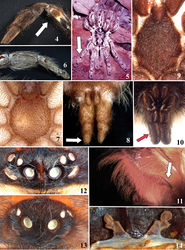

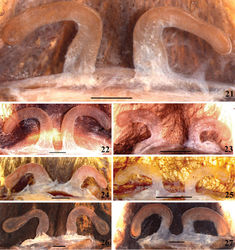

![Figures 173–180. Avicularia hirschii Bullmer et al. 2006[9], male holotype (SMF 57125). 173–176 right palpal bulb (mirrored) 173 prolateral 174 retrolateral 175 frontal 176 dorsal 177 right cymbium, dorsal (mirrored) 178–180 left tibia I 178 prolateral 179 ventral 180 retrolateral. Scale bars = 1 mm.](https://species-id.net/o/thumb.php?f=Zookeys-659-e10717-g042.jpg&width=197)
